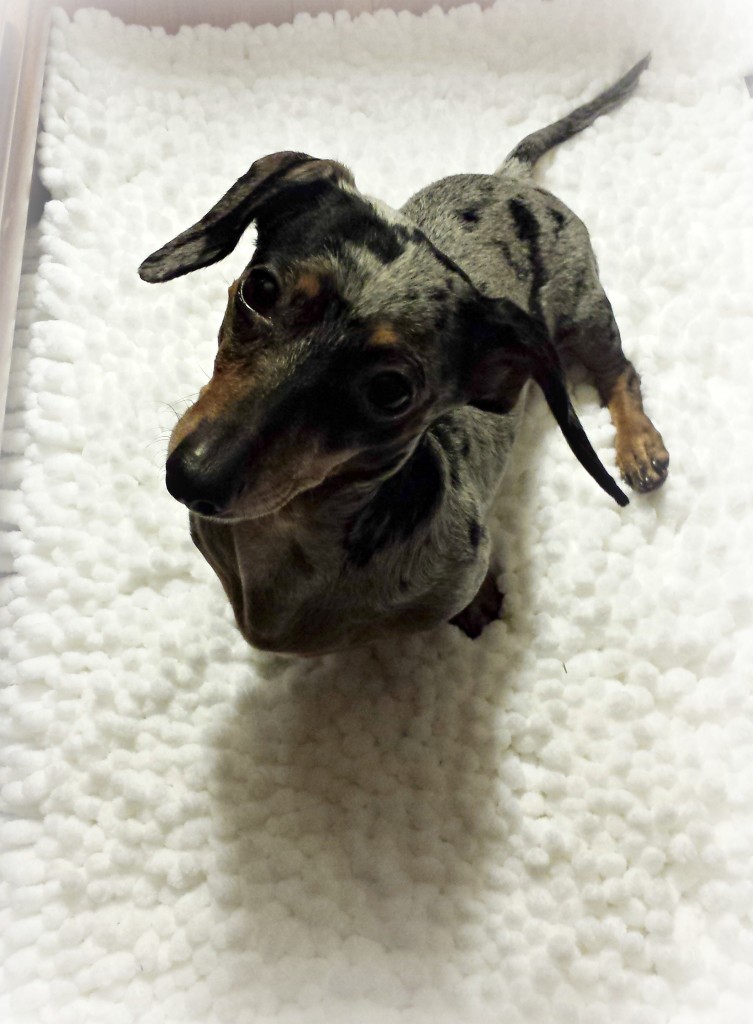 Over a year ago I had every intention of adopting another dachshund with IVDD who needed a wheelchair. And when I found Gidget I thought perhaps she was in need of a wheelchair — but whether she needed it or not, I just knew we were meant to be together and my heart was head over heels in love with her. But when she got here, I could see that she does quite well walking on her own, even though she does have IVDD.
Over a year ago I had every intention of adopting another dachshund with IVDD who needed a wheelchair. And when I found Gidget I thought perhaps she was in need of a wheelchair — but whether she needed it or not, I just knew we were meant to be together and my heart was head over heels in love with her. But when she got here, I could see that she does quite well walking on her own, even though she does have IVDD.
She is a bit wobbly at times, and if she gets too excited and runs around too fast, her little backend can’t keep up, and she will flop onto her side. But within seconds she picks herself back up and is on her merry way.
When she got here I expressed her bladder 3-4 times a day, but discovered she will go a little on her own. And then I discovered that it seems like she actually loves to sniff around outside and seems proud to go potty on her own. Even though it can get quite cold here in Wisconsin during the winter, I’m enjoying taking her outside to do her thing.
Her one back leg she does have a hard time holding in place for too long while she squats, but she does a pretty good job. Though I still do need to express her fully as for whatever reasons, all the potty won’t come out on its own. And her bowels? Well, those have a mind of their own too and when they are ready to make their appearance…. well, they just do. But with a little skill and paying attention, often times I can get her outside or over the toilet for this.
And I know perhaps this may sound odd, but all those years I had Frankie, who was completely down and in a wheelchair, it has been a new kind of joy to be a part of this different stage of IVDD with Gidget.
When I hear from others, just as I did this week, of someone who had no hope because she couldn’t afford surgery for her dachshund who recently went down, I can speak with even more conviction now that you just never know how things will turn out — even without surgery. Gidget never had surgery and she is walking – yes, sometimes wobbly, but she is walking.
Frankie had the surgery and never walked again. You just never know. There are so many different stages of IVDD. The best thing you can do should this happen to your dog is to get them in a crate and do crate rest for 8-weeks (and see a specialist ASASP) should you not choose surgery as an option. Even then, 6-weeks strict cage rest is essential. Dodgerslist is a great resource for pet owners whose dog has been diagnosed with IVDD.
No matter what, there is always hope with a diagnoses of IVDD. Sadly, this isn’t always told to pet owners when they bring their downed dog in.
I recall when I used to dog sit for a little dachshund, Kirby who didn’t have IVDD. Sometimes my heart would ache because he and Frankie would be looking out the front door and to see their little behinds was so cute – but I’d have moments of sadness that Frankie was in a wheelchair. Even though I was so happy she was living a quality life, I’d still miss that part of how she used to be.
With Gidget, when I see her standing and looking out the front door, her little behind so petite, I often find tears pooling in my eyes – to witness this with her has been such sweetness, but then it will also have me missing my doxie’s that were in wheelchairs.
But experiencing the different stages of IVDD has me wanting to always be here to keep sharing the GOOD NEWS that dogs with IVDD can be happy and thrive. Adopting Gidget and watching her thrive in a different way than Frankie and Joie, has had different and beautiful rewards for me.
There is, and always will be, hope!
